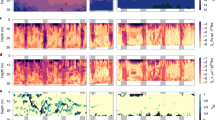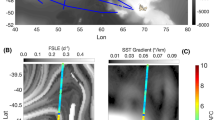Abstract
The characteristics and forcing mechanisms of high-frequency flow variations (periods of minutes to days) were investigated near Gladden Spit, a reef promontory off the coast of Belize. Direct field observations and a high-resolution (50-m grid size) numerical ocean model are used to describe the flow variations that impact the initial dispersion of eggs and larvae from this site, which serves as a spawning aggregation site for many species of reef fishes. Idealized sensitivity model experiments isolate the role of various processes, such as internal waves, wind, tides, and large-scale flow variations. The acute horizontal curvature and steep topography of the reef intensify the flow, create small-scale convergence and divergence zones, and excite high-frequency oscillations and internal waves. Although the tides in this area are relatively small (∼10-cm amplitude), the model simulations show that tides can excite significant high-frequency flow variations near the reef, which suggests that the preference of fish to aggregate and spawn in the days following the time of full moon may not be coincidental. Even small variations in remote flows (2–5 cm s−1) due to say, meso-scale eddies, are enough to excite near-reef oscillations. Model simulations and the observations further suggest that the spawning site at the tip of the reef provides initial strong dispersion for eggs, but then the combined influence of the along-isobath flow and the westward wind will transport the eggs and larvae downstream of Gladden Spit toward less turbulent region, which may contribute to enhanced larval survival.













Similar content being viewed by others
References
Armstrong BN (2003) Currents along the Mesoamerican Barrier Reef, Western Caribbean. M.S. dissertation, University of South Carolina
Barlow GW (1981) Patterns of parental investment, larval dispersal and size among coral reef fishes. Environ Biol Fish 6(1):65–85
Claro R, Lindeman K (2003) Spawning aggregation sites of snapper and grouper species (Lutjanidae and Serranidae) on the insular shelf of Cuba. Gulf Caribb Res 14(2):91–106
Cowen RK, Paris CB, Srinivasan A (2006) Scaling of Connectivity in Marine Populations. Science 311:522–527
Ducet N, Le Tron PY, Reverdin G (2000) Global high-resolution mapping of ocean circulation from TOPEX/Poseidon and ERS-1 and -2. J Geophys Res 105:19477–19498
Eriksen CC (1982) Observations of Internal Wave Reflection off Sloping Bottoms. J Geophys Res 87(CI):525–538
Ezer T (2005) Entrainment, diapycnal mixing and transport in three-dimensional bottom gravity current simulations using the Mellor-Yamada turbulence scheme. Ocean Model 9(2):151–168
Ezer T (2006) Topographic influence on overflow dynamics: Idealized numerical simulations and the Faroe Bank Channel overflow. J. Geophys Res 111 (C02002), doi:10.1029/2005JC003195
Ezer T, Mellor GL (2004) A generalized coordinate ocean model and a comparison of the bottom boundary layer dynamics in terrain-following and in z-level grids. Ocean Model 6(3–4):379–403
Ezer T, Thattai DV, Kjerfve B, Heyman WD (2005) On the variability of the flow along the Meso-American Barrier Reef system: a numerical model study of the influence of the Caribbean current and eddies. Ocean Dyn 55:458–475
Garrett C, Munk W (1979) Internal waves in the ocean. Ann Rev Fluid Mech 11(A79-24751 09-34):339–369
Heyman WD, Graham RT, Kjerfve B, Johannes RE (2001) Whale sharks Rhincodon typus aggregate to feed on fish spawn in Belize. Mar Ecol Prog Ser 215:275–282
Heyman WD, Requena N (2003) Fish spawning aggregation sites in the MBRS region: Recommendations for monitoring and management. MBRS Technical Document No. 16, Mesoamerical Barrier Reef System Project, Belize City, Belize, 49p (available from The Nature Conservancy, Arlington, Virginia; www.conserveonline.org)
Heyman WD, Kjerfve B, Graham RT, Rhodes KL, Garbutt L (2005) Spawning aggregations of Lutjanus cyanopterus (Cuvier) on the Belize Barrier Reef over a 6 year period. J Fish Biol 67(1):83–101
Heyman WD, Ecochard JB, Biasi FB (2007) Low-cost bathymetric mapping for tropical marine conservation—a focus on reef fish spawning aggregation sites. Mar Geodesy 30(1):37–50
Heyman WD, Kjerfve B, Ezer T (2008) Mesoamerican reef spawning aggregations help maintain fish populationspopulation: a review of connectivity research and priorities for science and management. In: Grober-Dunsmore R, Keller BD (eds) Marine Sanctuaries Conservation Series ONMS-08-07. NOAA, Silver Spring, pp 150–169
Heyman WD, Kjerfve B (2008) Characterization of transient multi-species reef fish spawning aggregations at Gladden Spit, Belize. Bull Mar Sci 83(3):531–551
Hotchkiss FS, Wunsch C (1982) Internal waves in Hudson Canyon with possible geological implications. Deep Sea Res 29(4):415–442
Hsu M-K, Liu AK, Liu C (2000) A study of internal waves in the China Seas and Yellow Sea using SAR. Cont Shelf Res 20(4–5):389–410
Huang NE, Shen Z, Long SR, Wu MC, Shih EH, Zheng Q, Tung CC, Liu HH (1998) The Empirical Mode Decomposition and the Hilbert spectrum for nonstationary time series analysis. Proc R Soc Lond 454:903–995
Johannes RE (1978) Reproductive strategies of coastal marine fishes in the tropics. Environ Biol Fish 3:65–84
Kjerfve B (1981) Tides of the Caribbean Sea. J Geophys Res 86(C5):4243–4247
Kobara S, Heyman WD (2008) Geomorphometric patterns of Nassau grouper (Epinephelus striatus) spawning aggregation sites in the Cayman Islands. Mar Geodesy 31:231–245
Kobara S, Heyman WD (2010) Sea bottom geomorphology of multi-species spawning aggregation sites in Belize. Mar Ecol Prog Ser 405:243–254
Legg S, Adcroft A (2003) Internal wave breaking at concaveand convex continental slopes. J Phys Oceanogr 33:2224–2246
Lobel PS (1978) Diel, lunar, and seasonal periodicity in the reproductive behavior of the pomacanthid fish, Centrophyge potteri, and some other reef fishes in Hawaii. Pac Sci 32:193–207
Mellor GL, Yamada T (1982) Development of a turbulent closure model for geophysical fluid problems. Rev Geophys 20:851–875
Mellor GL, Hakkinen S, Ezer T, Patchen R (2002) A generalization of a sigma coordinate ocean model and an intercomparison of model vertical grids. In: Pinardi N, Woods JD (eds) Ocean forecasting: conceptual basis and applications. Springer, New York, pp 55–72
Oey L-Y, Ezer T, Wang D-P, Yin X-Q, Fan S-J (2007) Hurricane-induced motions and interaction with ocean currents. Cont Shelf Res 27:1249–1263
Paris CB, Cowen RK (2004) Direct evidence of a biophysical retention mechanism for coral reef fish larvae. Limn Oceanogr 49(6):1964–1979
Rattray M (1960) On the coastal generation of internal tides. Tellus 12(1):54–62
Sheng J, Tang L (2004) A two-way nested-grid ocean circulation model for the Meso-American Barrier Reef System. Ocean Dyn 54:232–242
Sheng J, Wang L, Andréfouët S, Hu C, Hatcher BG, Muller-Karger FE, Kjerfve B, Heyman WD, Yang B (2007) Upper ocean response of the Mesoamerican Barrier Reef System to Hurricane Mitch and coastal freshwater inputs: a study using sea-viewing wide field-of-view sensor (SeaWiFS) ocean color data and a nested-grid ocean circulation model. J Geophys Res 112 (C07016), doi:10.1029/2006JC003900
Skirving WJ, Heron SF, Steinberg CR, Strong AE, McLean C, Heron ML, Choukroun SM, Arzayus LF, Bauman LG (2005) “Palau modeling final report”. National Oceanic and Atmospheric Administration and Australian Institute of Marine Sciences, Townsville. p. 46.
Sponaugle S, Cowen RK, Shanks A, Morgan SG, Leis JM, Pineda J, Boehlert GW, Kingsford MJ, Lindeman KC, Grimes C, Munro JL (2002) Predicting self-recruitment in marine populations: biophysical correlates and mechanisms. Bull Mar Sci 70(Suppl 1):341–375
Tang L, Sheng J, Hatcher BG, Sale PF (2006) Numerical study of circulation, dispersion, and hydrodynamic connectivity of surface waters on the Belize shelf. J Geophys Res 111 (C01003), doi:10.1029/2005JC002930
Tennekes H, Lumley JL (1972) A first course in turbulence. MIT Press, Cambridge, p 300
Werner FE, Cowen RK, Paris CB (2007) Coupled biological and physical models: present capabilities and necessary developments for future studies of population connectivity. Oceanography 20(3):54–69
Wright DJ, Heyman WD (2008) Introduction to the special issue: marine and coastal GIS for geomorphology, habitat mapping and marine reserves. Mar Geodesy 31:1–8
Wunsch C (1969) Progressive internal waves on slopes. J Fluid Mech 35:131–145
Acknowledgments
TE was partly supported by grants from NOAA and MMS. WH, CH, and BK were supported by grants from the Mellon Foundation, the World Bank, SDC and the Conservation International’s Marine Managed Area Science Program.
Author information
Authors and Affiliations
Corresponding author
Additional information
Responsible Editor: Huijie Xue
This article is part of the Topical Collection on 2nd International Workshop on Modelling the Ocean 2010
Rights and permissions
About this article
Cite this article
Ezer, T., Heyman, W.D., Houser, C. et al. Modeling and observations of high-frequency flow variability and internal waves at a Caribbean reef spawning aggregation site. Ocean Dynamics 61, 581–598 (2011). https://doi.org/10.1007/s10236-010-0367-2
Received:
Accepted:
Published:
Issue Date:
DOI: https://doi.org/10.1007/s10236-010-0367-2




